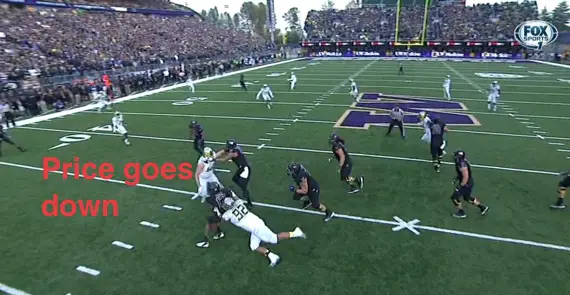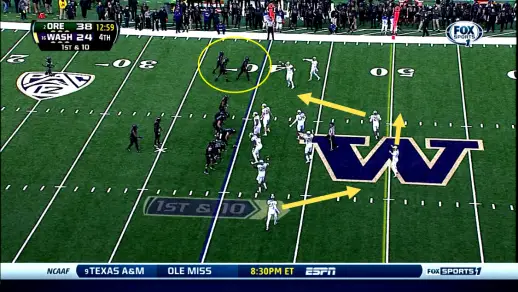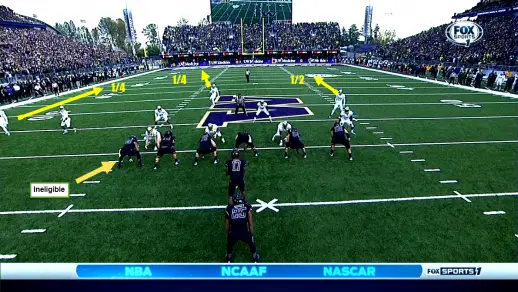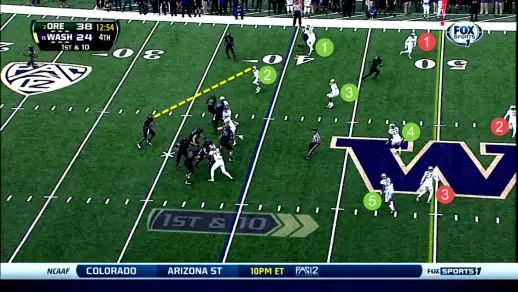The “Fire Zone Blitz” is one of the effective blitzes that the Oregon hybrid 3-4 defense uses to pressure a Quarterback. The Ducks do a great job of bringing heavy pressure with 5-man zone blitzes, and then bringing 4 or often, only 3 pass rushers, but there’s another weapon that helps Duck defensive linemen get to the passer.
Having success from a great zone coverage in the secondary can also create coverage sacks for the Ducks’ defensive line, however, bringing only 3 pass rushers makes possible dropping 8 defenders into coverage. But there is risk with this as the QB usually has more time to find an open receiver with the lighter pass rush.
At Washington in 2013, the Ducks defense struggled to stop the Huskies’ running back Bishop Sankey, while harassing Washington QB Keith Price all day, limiting the passing attack and allowing the Ducks to finally pull away in the 4th quarter. The Oregon defense registered 4 sacks, along with numerous hurries, forcing Price to scramble repeatedly. And, while Oregon didn’t abandon the blitz package, it was limited. Many of those unsuccessful passing downs for the Huskies came despite the Ducks bringing only 3 pass rushers, so it was the excellent zone coverage by the Ducks that took away all of the options for Price.
One of those big coverage sacks came early in the 4th quarter when the Huskies had a 1st-and-10 from their own 40 and needed a scoring drive to stay alive. Here, the Ducks’ Nose Tackle Wade Keliikipi got to the QB to put Washington into a hole they wouldn’t recover from. It was a superb pass rush by Wade, but it was the zone coverage by Oregon that made it happen.
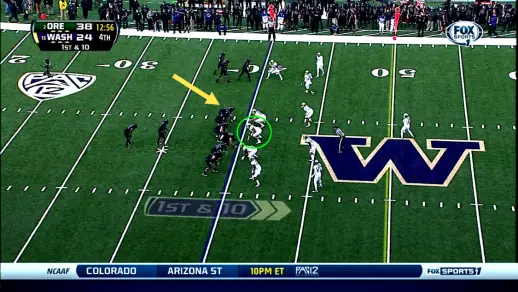
Washington lined up in an unbalanced formation (above) with trips left. Their Tight End was on the same side as the wide receivers and covered up, meaning he was ineligible to receive a pass. The Ducks front recognized this and adjusted. Keliikipi normally plays over the Center, but with the unbalanced line everyone shifted one man over to the strong side, putting Wade in front of or ‘over’ the Left Guard.
Of more importance was the Oregon secondary recognizing the Bunch (trips) set and they adjusted. The Safety (above) rolled down (moved up to the LOS) and the coverage adjusted to a Quarter-Quarter-Half coverage deep. This means the Bunch side Corner and Safety are responsible for deep 1/4’s of the field, and the back side Corner is responsible for the deep half of his side of the field.
This variation on Cover 3 is a common zone coverage adjustment for unbalanced receiver formations. With only a 3-man rush, the Ducks had 5 underneath zone defenders along with the 3 deep defenders. The Huskies were left with nowhere to go with the football.
The success of Bunch routes by an offense comes from creating confusion, to lose the defenders. Let’s look at how Oregon stopped it and created a sack!
A lot of work goes into defending Bunch sets like the one Washington used in this example. For Oregon, one defender was responsible for outside routes (green circle No. 1, above). Another defender was responsible for the receiver moving down the field (red circle No. 1, above).
A third defender (green circle No. 3, above) was responsible for any inside breaking route from the Bunch alignment. The deep route on this play was handled by the two deep 1/4 defenders. The Outside Linebacker jammmed the outside releasing route, cancelling it.

The route that Price wanted to throw, was taken away by the Safety, (green circle No. 2, above) as the Huskies wanted to throw the quick pass to the bubble receiver at the top. When the Safety saw the route being run in the backfield, he jumped it immediately, and Price was unable to use the route — unless he wanted to throw a Pick 6.
But don’t underestimate the amount of work that goes into the communication the Ducks used to get into the right call. Although seemingly simple, the on-field communication takes a ton of repetition and coaching. With all of the complexities to this formation, the Duck defenders did a great job of getting everyone in the right places.

Keliikipi did his part as well, beating the double team from the Huskies’ pass protection. Note how he slapped and turned the shoulders of the offensive lineman. And, as we learned from the Taylor Hart analysis recently — pass blocking cannot happen unless the shoulders of the offensive lineman are square. Wade had plenty of time to make it happen, because the 4th sack of the day for the Ducks was a definite coverage sack.
It’s a huge advantage for the Defensive Coordinator when he doesn’t have to blitz to get to the Quarterback!
I may be in Virginia, but “oh, how we love to learn about your beloved Ducks!”
Coach Joe Daniel
Richmond, Virginia
Website: http://football-defense.com
Twitter: @footballinfo (http://twitter.com/footballinfo)
Facebook: http://facebook.com/footballdefense
(All pictures above from Video)
Joe Daniel (Football Analyst) is the author of Football-Defense.com and Football-Offense.com, and host of The Football Coaching Podcast. Coach Daniel has written over 300 articles and produced six eBooks on coaching football. With 10 years in coaching both High School and College Football, he will be the Defensive Coordinator for Prince George High School in Prince George, Virginia for the 2012 season.

